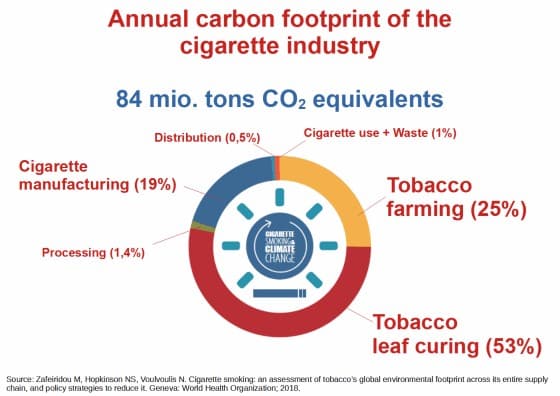Apart from killing millions of people each year, Big Tobacco’s carbon footprint is destroying the earth in a way not many people know about.
A report released by the World Health Organization (WHO) detailed the damaging impact of the tobacco industry on the planet and people’s health in its report “Tobacco: Poisoning our planet”.
The industry’s actions have a domino effect. Growing, manufacturing, shipping, selling, using, and disposing of tobacco products all degrade the environment and harm health.
Big Tobacco Carbon Footprint
Big Tobacco refers to the four largest companies in the tobacco industry. They include Philip Morris International, British American Tobacco, Imperial Brands, and Japan Tobacco International.
The industry’s main product, tobacco, causes far-reaching damage to the environment.
Each year, the tobacco industry takes more than 8 million human lives, cuts 600 million trees, 200,000 hectares of land, 22 billion tonnes of water, and emits 84 million tonnes of CO2.
It also creates the world’s most littered item – cigarette butts.
Big tobacco’s carbon emissions alone are equal to ⅕ of what is released by the aviation industry. CO2 comes from producing, processing and shipping tobacco products.
Estimates further say that every cigarette emits about 14 grams of CO2 while tobacco production releases 84 million tonnes of CO2e according to a study by Zafeiridou et al.:
- Despite these facts, tobacco companies are still claiming that they’re becoming sustainable.
A lead author in WHO’s report, Andrew Rowell, said that the industry is never held accountable for the environmental effects of its products and their global supply chain.
“In fact, the industry’s ecological impact is roughly equivalent to one of the large oil companies. We need to talk about big tobacco the same way we talk about big oil as a cause of climate change.”
The process of curing tobacco leaves to produce dry tobacco is very energy intensive. The procedure burns wood or uses coal, contributing to GHG emissions as well as deforestation.
Deforestation is another major driver of global warming by being a significant source of carbon emissions. Cutting down trees releases the CO2 they store into the atmosphere.
Studies also show that big tobacco companies together are cutting down 600 million trees each year to make cigarettes. Estimates say that it takes about 1 tree to produce around 15 packets of cigarettes.
Most tobacco crops are cultivated in low or middle-income regions where water and farm are critical to produce food. Yet, they are used to grow the damaging tobacco plants, WHO said. This leads to clearing more and more forests.
Plastic and Chemical Wastes of Cigarettes
Growing tobacco crops to produce cigarettes is not the only concern. Tobacco products are also creating mountains of waste that damage the environment and human health.
A director from WHO noted that:
“Tobacco products are the most littered item on the planet, containing over 7000 toxic chemicals, which leech into our environment when discarded…”
He added that about 4.5 trillion cigarette filters pollute the oceans, rivers, city sidewalks, parks, soil and beaches each year.
Cigarettes contain filters which are made of plastic. Filtered cigarette butts are a part of the plastic pollution problem. And these filters are among the top 10 most common plastics in the world’s oceans.
Worldwide, they are the 2nd largest source of plastic pollution.
Each filter that is littered can pollute up to 100 liters of water.
Adding to this plastic littering issue are other products like e-cigarettes and smokeless tobacco.
The worst case – who pays for the cleanup of tobacco litters?
It’s not the big tobacco companies themselves but the taxpayers.
Every year, cleaning up the litter costs Germany and Brazil over US$ 200 million each; while China spends about US$ 2.6 billion and India US$ 766 million to do the same.
Who Must Pay?
Though it wasn’t in the case of cleaning up the litter, the US Justice Department sought to recover billions of dollars paid for by the government health programs to treat smokers in 1999.
This civil lawsuit was the largest ever brought by the DoJ. It claims that smoking cigarettes causes lung cancer and other diseases, resulting in $25 billion annual health claims.
The case also alleged that the big tobacco companies conspired to hide their products’ health risks and deceive the public.
The lawsuits ended up in the largest settlement in US history at US$ 206 billion. But this amount only ended up being paid for by smokers through higher tobacco prices.
An industry watchdog claimed that alternative cigar products were nothing more than greenwashing. They said that the industry’s public relations messages mislead consumers.
When it comes to reducing tobacco’s carbon footprint, some countries have made a decision.
For instance, the Polluter Pays Principle that some European countries follow seek to make the tobacco industry responsible for paying the cost of their pollution.
Britain also warned big tobacco companies to pay the $55 million annual cost of cleaning up discarded cigarette butts.
The WHO calls for strong tobacco taxes, which may include carbon tax, and more support services to help smokers quit. The health organization even called out to farmers to grow other sustainable crops than tobacco.
Imposing carbon tax on cigarettes will further increase the price while cutting the industry emissions. But it seems that there’s no estimations yet as to how much it can be exactly.
Today, the big oil companies are also in the same position as the big tobacco companies in 1999. Both industries lied about the dangers of their products to the people and the planet.
And like the tobacco industry and its huge carbon emissions, the fossil fuel industry, which is the biggest polluter, is now facing multiple climate lawsuits.



